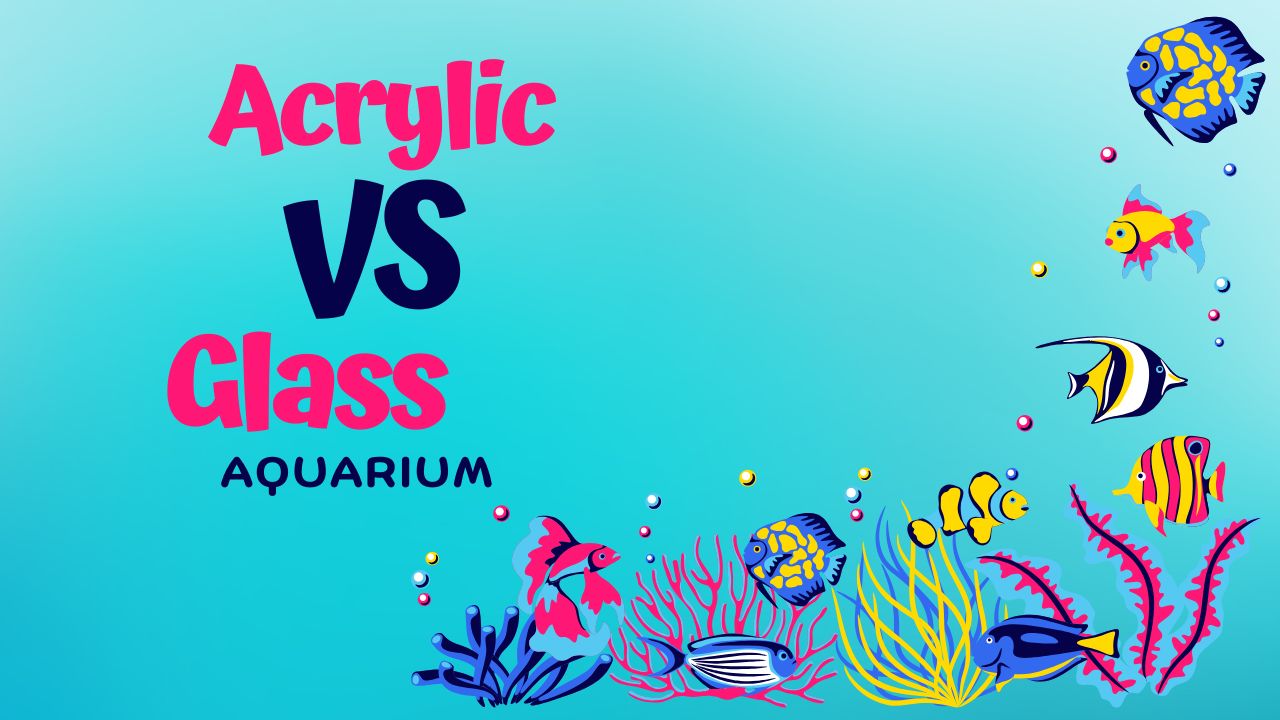Choosing between an acrylic and a glass aquarium can be a challenging decision for any fish enthusiast. Each type has its strengths and weaknesses.
Acrylic aquariums are generally lighter and offer better insulation, making them easier to manage and more energy-efficient, while glass tanks are known for their durability and crystal-clear visibility.

Understanding the unique features of both materials can help aquarium owners make an informed choice.
Acrylic is flexible and can be customized easily, while glass provides a classic look and less maintenance in the long run.
As they navigate this important decision, readers will discover how each option can impact their aquarium setup and fish care. By exploring the pros and cons of acrylic versus glass tanks, they can set up the ideal aquatic environment for their fish.
Contents
- 1 Table of Contents
- 2 Definitions and Key Differences
- 3 Pros and Cons of Acrylic Aquariums
- 4 Pros and Cons of Glass Aquariums
- 5 Durability and Longevity Comparisons
- 6 Maintenance and Care
- 7 Cost Analysis and Budget Considerations
- 8 Heat Retention and Insulation Properties
- 9 Environmental Impact and Sustainability
- 10 Choosing the Right Aquarium for Your Needs
- 11 FAQs:
- 11.1 What are the main differences between acrylic vs glass aquarium materials?
- 11.2 Which is more durable: acrylic vs glass aquarium?
- 11.3 Is it easier to maintain an acrylic vs glass aquarium?
- 11.4 Which provides better clarity: acrylic vs glass aquarium?
- 11.5 What is the best choice for large tanks: acrylic vs glass aquarium?
Table of Contents
Definitions and Key Differences
When choosing between acrylic vs glass aquariums, understanding their features is essential. Each material has specific benefits and limitations that cater to different needs.
Material Composition
Glass aquariums are made from silica and undergo a heating process that creates a strong, rigid structure. They are less flexible, which limits their design options.
Acrylic, on the other hand, is a type of plastic that is lighter and more malleable. This allows for creative, custom shapes that can enhance aesthetics. Acrylic can be formed into curved designs, providing a unique look not possible with glass. However, glass is generally more durable against scratches and damage from impact, while acrylic can crack under pressure.
Clarity and Visual Appeal
Both materials provide visibility of aquatic life, but their clarity differs.
Glass tanks often exhibit superior transparency, offering a sharp view without distortion. Many enthusiasts appreciate this quality for showcasing fish and decorations.
Acrylic tanks, while clear, can sometimes exhibit a slight distortion, especially in thicker panels. Acrylic does have an advantage in color brilliance; it can enhance the vibrancy of colors and allow for better lighting effects. Regular cleaning is required for both types to maintain their optical clarity.
Weight and Mobility
Weight is a significant factor when considering an aquarium’s placement.
Glass aquariums are generally heavier, which makes them challenging to move. A large glass tank may require extra hands or equipment for safe relocation.
In contrast, acrylic tanks are considerably lighter, making transportation easier. This property also makes acrylic suitable for households where the aquarium may need to be relocated frequently. However, the lightweight nature can make acrylic more vulnerable in certain environments, meaning extra care must be taken during movement.
Pros and Cons of Acrylic Aquariums
Acrylic aquariums offer distinct advantages and disadvantages compared to glass tanks. Understanding these points will help aquarists make informed choices.
Advantages of Acrylic
One of the main benefits of acrylic aquariums is their lightweight nature. Acrylic is significantly lighter than glass, making it easier to move and install. This feature is especially helpful for larger tanks, where weight can be a concern.
Acrylic also provides greater clarity. It has less distortion than glass, giving a clearer view of the aquatic environment. This clarity enhances the viewing experience.
Another advantage is insulation. Acrylic retains heat better than glass. This can lead to lower energy costs as heaters work more efficiently.
Additionally, acrylic tanks often allow for more customization. They can be formed into various shapes and sizes, appealing to unique design preferences. This flexibility can enhance the overall aquarium setup.
Disadvantages of Acrylic
Despite its advantages, acrylic aquariums come with some drawbacks.
One key issue is their susceptibility to scratches. While glass can also scratch, acrylic is more prone to this damage, which can mar its appearance.
Another concern is the higher cost. Acrylic tanks typically range from two to five times the price of glass tanks. This price difference can influence budget-conscious buyers.
Acrylic is also less durable than glass in some situations. Physical impacts can crack or shatter acrylic. Although it is less likely to break under pressure, it may not withstand heavy impacts as well.
Lastly, some aquarists find that acrylic can be more challenging to clean. Proper cleaning techniques are essential to avoid damaging the surface.
Pros and Cons of Glass Aquariums

Many aquarists consider glass aquariums for their durability and clarity. Each type has its benefits and drawbacks that affect the choice depending on individual needs and preferences.
Advantages of Glass
Glass aquariums are renowned for their affordability. Generally, they cost two to five times less than acrylic tanks, making them accessible for beginners.
They also offer superior scratch resistance, preventing surface damage over time. This is especially important in maintaining a clear view of the tank’s inhabitants.
Additionally, glass has less distortion compared to acrylic. This means that the fish and plants within the tank appear more true-to-life, enhancing the viewing experience.
Glass tanks are also heavier, which can be a benefit as it adds stability. Heavier tanks are less likely to tip over, which can be a concern in busy homes.
Disadvantages of Glass
Despite its benefits, glass aquariums come with challenges.
One significant drawback is weight. These tanks are much heavier than their acrylic counterparts, making them more difficult to move during setup or cleaning.
Glass is also more fragile. Though it resists scratches well, it is more prone to cracking or breaking if dropped or hit. This can pose a risk to both the aquarium and the surrounding area.
In terms of insulation, glass is less effective. It does not retain heat as well as acrylic, which can lead to fluctuations in water temperature.
Lastly, customizing glass aquariums may be more challenging. They typically offer fewer design options compared to the flexible nature of acrylic tanks.
Durability and Longevity Comparisons

When comparing acrylic vs glass aquariums, durability is a key factor.
Acrylic Aquariums:
- Impact Resistance: Acrylic is more resistant to impact. This makes it less likely to crack under pressure.
- Weight: Lighter than glass, making it easier to move and set up.
- Scratches: More prone to scratches, which can affect appearance over time.
Glass Aquariums:
- Durability: Generally more durable than acrylic. Glass can withstand higher levels of heat and UV exposure.
- Scratch Resistance: Less likely to scratch compared to acrylic. Scratches on glass can be polished out.
- Longevity: Glass tanks can last for decades if maintained well, keeping clarity and aesthetics intact.
Maintenance and Care

Caring for an aquarium involves specific cleaning techniques and considerations regarding scratch resistance. The material of the aquarium—whether acrylic or glass—affects how a person should maintain it.
Cleaning Techniques
When cleaning an aquarium, it’s important to choose the right tools based on the material.
For glass aquariums, a soft cloth or sponge can be used with regular aquarium-safe cleaners. These tools prevent scratches and effectively remove algae build-up.
Acrylic aquariums require extra caution. Using abrasive materials can cause scratches. It is best to use specially designed acrylic cleaners and soft, non-abrasive sponges. He or she should clean both the inside and outside surfaces regularly to maintain clarity and prevent grime.
Scratch Resistance
Scratch resistance varies significantly between acrylic vs glass aquariums.
Glass is more resistant to scratches compared to acrylic tanks. This means that glass aquariums may remain clear and undamaged even with frequent cleaning.
On the other hand, acrylic aquariums are lightweight and shatter-resistant. However, they can be prone to scratches, which can affect visibility over time.
This is particularly important for individuals who plan to modify their tanks by drilling or making other changes, as these activities can increase the risk of scratching.
Cost Analysis and Budget Considerations

When choosing between an acrylic vs glass aquarium, cost is a major factor. Both options have different price ranges and long-term expenses.
Initial Cost:
- Acrylic aquariums typically have a higher upfront cost compared to glass tanks.
- Prices can vary based on size and brand.
Maintenance Costs:
- Acrylic tanks may offer lower maintenance costs over time.
- They are less prone to scratches, which can reduce replacement needs.
Durability:
- Acrylic aquariums usually last longer than glass, which can make them a better investment.
- Glass aquariums, while often cheaper initially, may require more frequent replacements.
Weight and Installation:
- Acrylic is lighter, which can reduce costs related to supports and stands.
- Glass tanks are heavier and may need sturdier furniture, affecting overall costs.
Resale Value:
- Resale value can vary. Acrylic tanks may appeal more to some buyers due to their clarity and design options.
Heat Retention and Insulation Properties

Acrylic aquariums generally provide better insulation than glass aquariums. They are known for their ability to retain heat, which helps create a stable environment for fish and plants.
Key Differences:
- Insulation: Acrylic has more than 30% greater insulation properties compared to glass. This means it keeps water temperatures more consistent.
- Heat Loss: Glass tends to lose heat quickly, making it less effective in colder environments. This can lead to higher energy costs if heating is needed.
- Weight Impact: The weight difference also plays a role. An empty glass tank can weigh almost double that of a similarly sized acrylic tank. This can affect setup and location options.
Acrylic’s lightweight nature makes it easier to manage, especially for larger tanks. This factor is important for hobbyists who may relocate their aquariums.
Additional Considerations:
- Temperature Stability: Acrylic enables consistent temperature, which is vital for aquatic life.
- Condensation: Due to better heat retention, acrylic tanks may experience less condensation on their surfaces compared to glass tanks.
Environmental Impact and Sustainability

When choosing between acrylic vs glass aquariums, it’s important to consider their environmental impacts.
Acrylic Aquariums:
- Made from synthetic materials, which are derived from petroleum.
- Production involves chemical processes that can contribute to pollution.
- They are lighter, which may reduce transportation emissions.
Glass Aquariums:
- Made from natural materials like sand, soda ash, and limestone.
- These materials are abundant and recyclable, leading to a lower long-term impact.
- Glass consists of no harmful chemicals that leak into the water.
In terms of durability, acrylic is more prone to scratching. Glass, while heavier, lasts longer and can be recycled more easily.
When looking at sustainability, glass has the edge because of its recyclability. Acrylic can take up to hundreds of years to break down in landfills.
Choosing the Right Aquarium for Your Needs

Choosing between an acrylic vs glass aquarium involves assessing several factors. Each type has unique benefits that cater to different preferences and needs.
Weight and Size
- Acrylic tanks are lighter and easier to move.
- Glass tanks are heavier but can be larger for the same thickness.
Clarity and Maintenance
- Acrylic offers better clarity and won’t cloud over time.
- Glass tends to scratch more easily but can be polished.
Durability
- Acrylic is less likely to break, making it safer for homes with kids or pets.
- Glass can break but is generally more resistant to UV light.
Cost
- Acrylic tanks are usually more expensive due to manufacturing processes.
- Glass tanks are often more affordable and widely available.
Aesthetics
- Acrylic provides a seamless look and more design options.
- Glass tanks offer a classic appearance that many find appealing.
FAQs:
What are the main differences between acrylic vs glass aquarium materials?
Acrylic aquariums are lighter, more impact-resistant, and easier to shape, while glass aquariums are heavier, scratch-resistant, and typically more affordable.
Which is more durable: acrylic vs glass aquarium?
Acrylic aquariums are generally more durable as they are less prone to cracking or breaking. However, glass aquariums are more scratch-resistant and can maintain their appearance longer with proper care.
Is it easier to maintain an acrylic vs glass aquarium?
Glass aquariums are easier to maintain because they are less likely to scratch during cleaning. Acrylic aquariums require special care to avoid scratches when cleaning or handling.
Which provides better clarity: acrylic vs glass aquarium?
Acrylic aquariums often provide better clarity as they do not have the green tint found in standard glass. However, glass aquariums with low-iron glass can match acrylic in clarity.
What is the best choice for large tanks: acrylic vs glass aquarium?
Acrylic is usually better for large tanks due to its lightweight and structural strength, making it easier to transport and install. Glass is more suitable for smaller tanks or those on a tighter budget.




